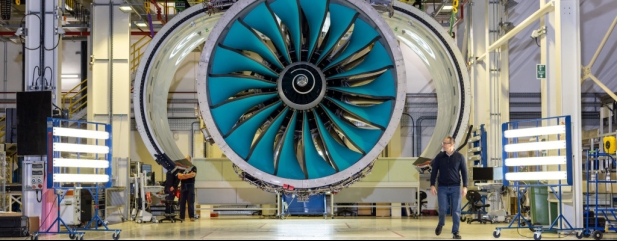Archived article
Please note that tax, investment, pension and ISA rules can change and the information and any views contained in this article may now be inaccurate.
How new boss Tufan Erginbilgic can transform the fortunes of Rolls-Royce

Having described Rolls-Royce (RR.) as a ‘burning platform’, new chief executive Tufan Erginbilgic has wasted no time in getting the share price roaring since he joined at the start of 2023.
Rolls-Royce was a jewel in the crown of UK engineering but over the last 10 years it has lost its way, struggling to generate sustained cash flow with the pandemic merely exacerbating its problems given its material exposure to the aviation sector.
A former executive of BP (BP.), Erginbilgic’s devastating assessment of Rolls-Royce’s difficulties has given the market belief he is serious about change and the share price is up 48% since he took the helm.
We think there is further to go in the recovery story under Erginbilgic and believe the results of a big investor day and strategic review later in 2023 could be a key catalyst to take the share price even higher.
The stock is still below pre-pandemic levels and a long way off its all-time highs from a decade ago.
BUSINESS DIVISIONS
Rolls-Royce currently has four divisions, all of which relate to power and propulsion. The largest is Civil Aerospace, accounting for more than 40% of revenue in 2022. Rolls-Royce designs and makes aircraft engines. It then derives a lucrative stream of income from spares and repairs contracts on this installed base of engines. The company has an estimated 52% market share and a large order book which should support further growth.
In theory this part of the group should enjoy significant pricing power and barriers to entry against competitors; an aircraft’s engine is a critical component that would be difficult for its customers to source elsewhere.
This has not translated into the kind of margins you would expect, even before Covid struck, and the company also suffered with problems on its Trent 1000 series of engines between 2016 and 2021 which damaged its credibility and were costly to fix.
In the Defence division, the company is a market leader in engines for military transport and patrol aircraft, with repair and maintenance again a vital component of its work. It also has a significant footprint in the naval space and is the sole provider for power plants for the UK submarine fleet. Of potential importance for its ESG (environmental, social and governance) credentials, it does not supply or make weapons.
The order book increased 30.7% to £8.5 billion in 2022 and with the conflict in Ukraine shifting the calculus for countries across the world in terms of military spending, there is a material opportunity for Rolls-Royce here.
WHAT DOES ROLLS DO OUTSIDE AEROSPACE AND DEFENCE?
The Power Systems division makes power and propulsion systems for a variety of end uses including large yachts, big land vehicles like those used in mining as well as microgrids for renewable power sites. Again, it has a large installed base from which it can derive aftermarket revenue.
The final part of the group which currently makes a negligible contribution is the New Markets division. This includes investments in new areas like small modular reactors and electrical aviation. Significant hopes are pinned on small modular reactor technology which could reduce the cost and time involved in bringing on stream new nuclear power.
Shore Capital analyst Jamie Murray believes the electrical aviation operations could be put up for sale once Erginbilgic has completed his strategic review, noting the company has ‘failed to commercialise on its current partnerships’. He draws the contrast with small modular reactors where costs are largely funded by the UK Government and says an order from the latter would see the market start to price in positive returns from this area.
Every part of the business will have to prove its worth under what is likely to be a demanding management team. Erginbilgic has already brought in a former colleague from BP, Nicola Grady-Smith, as chief transformation officer. Notably efficiency improvements (and a significantly higher oil price) saw BP labelled a ‘cash machine’ by its CEO Bernard Looney in November 2021, so Grady-Smith’s appearance at Rolls-Royce could be significant.
In Murray’s view there is likely to be a more centralised approach to investment decisions. He says: ‘Previously each division has allocated capital separately which has caused inefficiencies. Instead, we expect Rolls-Royce to announce a group-level allocation strategy, to limit waste and prioritise high return investments.’
PLAYING CATCH-UP ON MARGINS
Jefferies analyst Chloe Lemarie observes the forthcoming investor event, expected at some point in the second half of 2023, ‘could provide further uplift to estimates by providing a path to mid-teens margin for the group, catching up with its key peers’.
Lemarie name checks Safran (SAF:EPA) in this context, a French designer, developer and manufacturer of aircraft engines. Its margins are around 13% versus approximately 5% from Rolls-Royce.
Investment bank Berenberg says the company needs to establish how much of the margin differential versus peers is a function of poor commercial terms/pricing and how quickly can that be addressed, as opposed to it being a cost issue. It comments: ‘We expect it is much more the former than the latter at this point given the work of prior management teams, even if there is more that can be done on costs.
‘The core competencies of Rolls-Royce are such that it seems reasonable customers will ultimately accept that the company has to be able to generate sustainable returns, above its cost of capital, if it
is to be fully invested in technologies that are critical for the long-term sustainability of commercial aviation.’
Rolls-Royce’s income from its long-term servicing agreements in civil aerospace are linked to flight hours – the longer an engine is keeping an aircraft in the air, the more maintenance it will need.
DEALING WITH ITS DEBT PILE
With flights grounded, the pandemic had a devastating impact on this part of Rolls-Royce’s business and the company saw its borrowings move significantly higher as cash flow dried up. Net debt increased from £1.2 billion in 2019 to more than £5 billion in 2021.
The company made some progress to address this issue in 2022. Net debt fell to £3.2 billion as it realised benefits from the cost-cutting delivered by previous CEO Warren East and the September 2022 sale of its ITP Aero business for €1.7 billion to private equity group Bain Capital.
A 2023 price to earnings ratio of 34-times dropping to 22-times in 2024, based on consensus forecasts, does not look cheap.
However, earnings are recovering from a low base and we think as Erginbilgic puts flesh on the bones of the group’s medium-term ambitions investors will react and mark the shares higher.
He is also fortunate to benefit from wider tailwinds as the aviation space continues its recovery from the pandemic.
We concede much is riding on what Erginbilgic has to say when he updates the market later this year and if he disappoints or the turnaround programme is seen as insufficiently ambitious, we may change our positive view on the shares.
As well as the nuts and bolts work of improving the way the business is run to increase efficiency and boost returns, Erginbilgic also needs to maintain an eye on the low-emission future demanded by government regulation as well as public, political and industry pressure.
If electrical aviation is not the answer, then it could be hydrogen or another form of technology. Rolls-Royce needs to make sure it is at the forefront of this transition.
Important information:
These articles are provided by Shares magazine which is published by AJ Bell Media, a part of AJ Bell. Shares is not written by AJ Bell.
Shares is provided for your general information and use and is not a personal recommendation to invest. It is not intended to be relied upon by you in making or not making any investment decisions. The investments referred to in these articles will not be suitable for all investors. If in doubt please seek appropriate independent financial advice.
Investors acting on the information in these articles do so at their own risk and AJ Bell Media and its staff do not accept liability for losses suffered by investors as a result of their investment decisions.
Issue contents
Editor's View
Feature
Great Ideas
News
- Aston Martin shares jump the gun in rush for profitable growth
- China’s new 5% growth target underwhelms as its focus shifts to boosting consumption
- Fresnillo suffers as costs surge and precious metals lose some shine
- Shaftesbury focused on income growth and cost cutting as it completes Capco merger
- ASOS shares gain 80% year-to-date on growing turnaround hopes

 magazine
magazine








